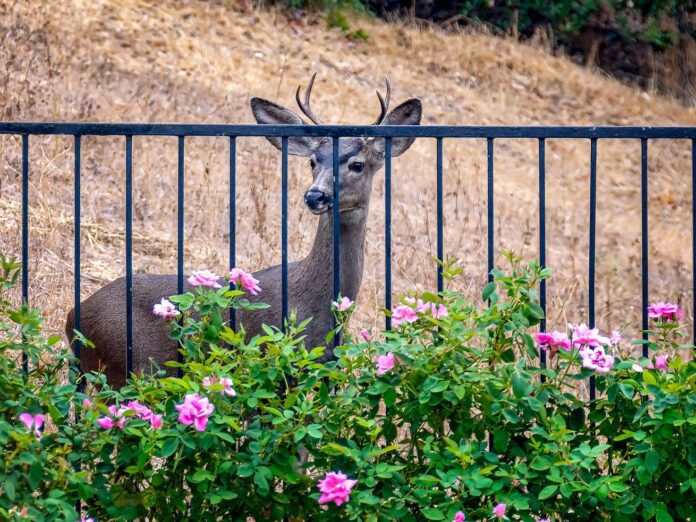[ad_1]

There are plenty of options to protect your family and property in ways that won’t harm innocent animals. Keep reading to learn how to create fencing that is friendly to wildlife.
Common types of fences can cause injury or death to animals because of the way they are constructed. Fences can also prevent them from finding food and water and separate young from their parents, leaving defenseless creatures stranded.
Large barriers can interfere with migration and even upset ecosystems. And as development continues unabated—be it for housing, commercial uses, or infrastructure—the more likely it is for animals to venture closer to our backyards.
Homeowners, however, can make conscious choices when it comes to fence materials and dimensions without causing undue harm to our neighbors in nature. Here’s how.
Learn About Local Wildlife
First up, research what types of animals are in your area and gain a basic understanding of their food sources, mating/breeding seasons, movement patterns, and if/when they migrate. Are there hungry predators in your area? Are there nearby herbivores likely to be tempted by your veggie patch?
Check with your local fish and game authority to see if your home lies in a migration corridor. Another way to find out is to simply explore: Look for tracks, scat, and other signs of animal crossings. If you have a sense of what animals you wish to keep off your property and which ones you’re happy to let pass through, you’ll be able to design a situation that works for all creatures great and small.
Consider Fence Alternatives
There are ways to create a secure and attractive barrier without relying on traditional fencing materials.
Tall hedges make handsome natural enclosures, and some may produce foliage and berries that animals eat—which may just keep critters from treating your garden like a buffet. Options include elderberry (Sambucus, USDA Hardiness Zones 3-9) and thimbleberry (Rubus parviflorus, USDA Hardiness Zones 4-10). Trees, bamboo, and a host of other sturdy plants can also form a living fence.
A stone wall can be a lovely addition to your landscape without getting in the way of wildlife. Whether you want the real deal or prefer to go prefab, This Old House has tutorial guidance.
Ways to Make Your Fence Wildlife-Friendly
Homeowners can employ certain design and logistical basics to make sure their fence is kind to wildlife. Depending on your location—suburb, exurb, or rural—the following general rules may apply:
- Avoid blocking paths that wildlife uses to find sustenance and migrate.
- Visibility is key. Animals must be able to see the fence. Wood rail fencing is more visible than thin wires, for example, but attaching small markers or flags to wire can make it easier for wildlife to see
- Steer clear of materials, such as barbed wire, as well as jagged or otherwise broken areas in fencing, that could snag, impale, entangle, or otherwise trap or injure animals.
- Don’t impede movement. Ideally, a fence will have ample space at the bottom (rather than be flush with the ground), so creatures can crawl under, and be low enough to leap and fly over. There should also be adequate room between wires or boards.
Enclose only what’s necessary
Do you really need a full-on fence around your entire property? Your yard will look more spacious and be more wildlife-friendly if you merely enclose smaller zones, such as a vegetable garden to deter nibblers or a dog run to give pooches a place to play safely.
Electric fences are an option to prevent predators from, say, accessing a chicken coop or apiary. While there will be some creature discomfort at first, the likes of foxes and coyotes ought to be wily enough to quickly figure out where they’re not welcome.
Choose accessible fence designs
A simple wooden post-and-rail fence looks great and will be visible to wildlife. It should be no higher than 40 inches, and a two-rail version is superior to one with three rails, as it can allow an entry point for young animals, such as fawns, who may be too small to successfully jump over the top. Another rustic, attractive choice is a worm fence that is easily visible. It is comprised of alternately stacked rails—just keep it under three feet high.
Though certainly visible, a buck fence (a.k.a. jackleg fence) isn’t the most wildlife-friendly option because its three-dimensional construction creates a bulky obstruction that makes it difficult for animals to clear completely. Avoid chain link if at all possible, as small animals cannot crawl under it and could become trapped in its mesh.
Use wire wisely
When it comes to wire, often employed around larger properties to contain livestock, smooth is better than barbed. Top and bottom wires, at the very least, should be smooth, to avoid harming leaping and crawling creatures. The top wire should ideally be no higher than 40 inches, with 12 inches between wires and 18 inches between the bottom wire and the ground. Markers or flags along the wires increase visibility.
Let wildlife through
Consider building in gates or drop-down sections along a fence to allow animals access to their habitat. Leaving these exits open is especially important for migrating animals. If your home lies in a migration corridor, and if so, remember to open gates or lower the drop-down sections of fencing during migration season so wildlife can move freely.
Maintain fencing properly
Fences that are in disrepair present more of a hazard than well-kept ones. Loose wires, broken rails and pickets, sharp edges, and the like can snag, snarl, and poke wildlife trying to pass through. Regularly check your fence for damage, especially after storms and a winter season with heavy snow, and repair it immediately.
[ad_2]
www.thisoldhouse.com










